My video application for Naked and Afraid. MY ACTUAL APPLICATION ONLY GOES TO 4:20.
The survival skills you’ll learn here can be used if there is a natural disaster or if you are lost in the wilderness. You never know when you might be stuck in an emergency situation. You’ll find information here on the basic survival skills you need to keep yourself and others alive.
You will also find wilderness survival skills if you want to spend weeks or months in the wilderness. These are more long-term primitive survival skills like making bows and arrows, fish spears, baskets and cordage. You will also discover how to make more permanent survival shelters, store food, and tan animal hides into leather.
Survival Skills
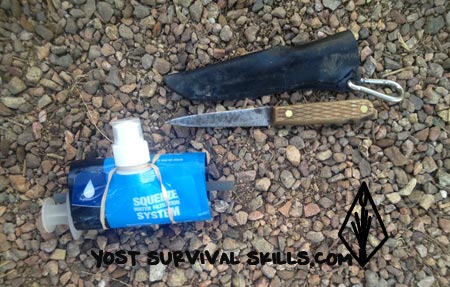
I want you to learn survival techniques that really work, from someone who knows what they’re talking about. I see so much b.s. online that it scares me. Because if you follow the advice of some sites and videos I’ve seen, you’re going to die! It would be great if you came and learned from me, someone who has spent his lifetime learning outdoor survival skills. Click here if you are interested in booking a day or week with me.
The 7 core survival skills are:
Attitude
Shelter
Water
Fire
Food
Signaling
Wilderness Navigation
Wilderness Survival Skills
Survival Shelters: How to construct a shelter and stay protected from the elements.

Water in a Survival Situation: Finding water and purifying it if you have to.

How to Make a Fire: Fire by friction and modern methods.

Survival Food: Finding and preparing edible plants, insects and animals in the woods.

Wilderness Navigation. How to find direction and navigate in the wilderness.

Wilderness Survival Skills: Survival skills for long-term survival, either months or years.

Attitude
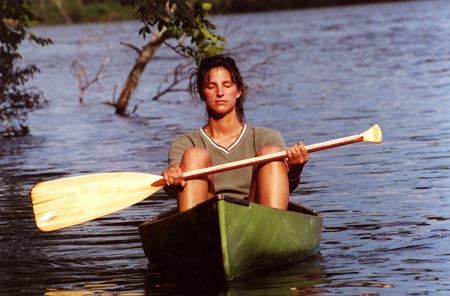
By far the most important survival tool you have is your brain and your ability to control yourself. There are many cases where skilled survivalists have died in “normal” circumstances and every year young children with no survival skills at all make it through some pretty tough survival situations.
Ignorance may be bliss and those young kids just kept their cool, stayed put, and waited for help because they didn’t know what else to do. In every instance, the kids were scared, but they didn’t let their emotions get the best of them. They conserved energy and stayed relatively calm.
A book called Deep Survival is the best book I’ve ever read about the difference between people who live and the people who die. The ability to think logically in times of emotionally difficult situations is the key.
You always hear people saying not to panic in a survival situation, but the fact is that humans are hard-wired to panic when emotions run high. And while acting out of emotion is usually good under high-stress circumstances, acting on emotion will get you killed in a survival situation.
What you have to do is stop. Just stop whatever you are doing and think. Then after you’ve logically thought of a next step, take action. Don’t just react to the situation. Make a logical plan and execute that plan.
But… and this is really important… if things change, you have to change your plan. Re-evaluate the situation and be ready to alter your original plan.
Having an attitude like this allows you to remain calm, flexible and use your survival skills to stay alive.
If you want to learn more about what it takes to stay alive in high-stress situations, I highly recommend getting a copy of Deep Survival. It’s an excellent book and it might save your life.
Top of survival skills page
Survival Shelters
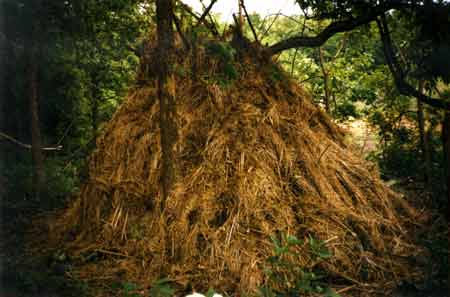
The number one cause of death in a survival situation is exposure to the elements. People get cold and die of hypothermia. They get too hot and die of dehydration, hyperthermia or heat stroke. If you’ve mastered making survival shelters, you can avoid these kinds of life-threatening situations.
There are a few important considerations when building a survival shelter:
- Location: build above the flood line and out of dry washes. Construct your survival shelter away from rocks that might fall off a cliff. Also, don’t build under dead tress that could come down.
- Material: Build your shelter where there is a lot of material close by. You don’t want to waste daylight and energy hauling rocks, leaves and branches over long distances.
- Protection from the elements: If it might rain, waterproof it as best you can. Make your survival shelter thick enough to keep you warm on its own if you can’t build a fire in the shelter. In the desert you’ll want a shelter that keeps you shaded in the daytime as well.
Learn how to make survival shelters.
Top of survival skills page
Water
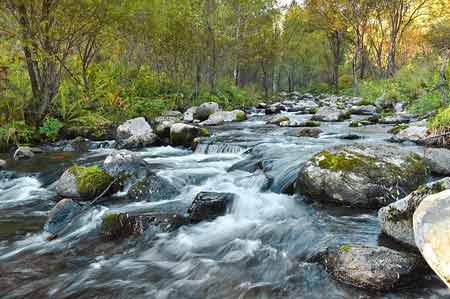
You can only live five days with no water if you aren’t active. If you are active and don’t drink water, you might only have two or three days before your body shuts down and you die.
The number one rule on water is, if you have it, drink it. People have died with water in their Nalgene bottles and canteens.
When you run out of the water you brought with you, you are going to have to find a water source and purify the water. There are a lot of ways to purify water: chemicals, ultraviolet light, filters and boiling. Probably the best method to purify water is boiling.
I’ve read that you need to boil water for two to ten minutes, and then adjust based on your altitude. There’s a better way to know when your water is purified by boiling. Water is safe to drink when it’s boiling so hard that when you stir it, it just keeps boiling. Use that as your barometer to decide if everything in the water is dead and you’ll be okay.
Learn how to find and purify water in the wilderness.
Top of survival skills page
Fire
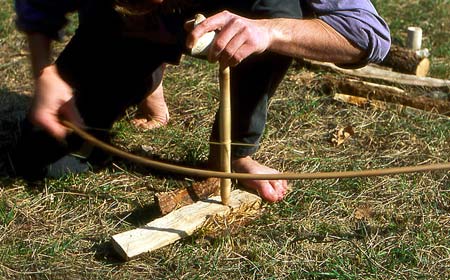
Fire is great to have in a survival situation and it’s a fun survival skill to practice, but fire is usually just a convenience. When you have fire you can boil water, cook food, harden spears and arrows, dry your clothes and warm yourself up.
Building a fire in a survival situation can be a life-saver because it makes you focus on something besides how desperate things seem. A lot of survivors from desperate situations say that concentrating on making a fire relaxed them and took their minds off their circumstances. Then after the fire was built, they said watching the flames and coals was calming and allowed them to think more clearly.
You should bring some kind of modern fire-starter with you when you go on treks. Butane lighters are great because they work well in bad weather. Other good options are ferrous rods or magnesium fire-starters.
Learning to make fire without modern tools takes practice and you should practice survival skills like flint and steel as well as friction fires before you need a fire to stay alive.
The bow drill and the hand drill are the easiest methods to start primitive fires with. I have great articles and videos to show you how to do it yourself.
Learn how to make a fire.
Top of survival skills page
Food
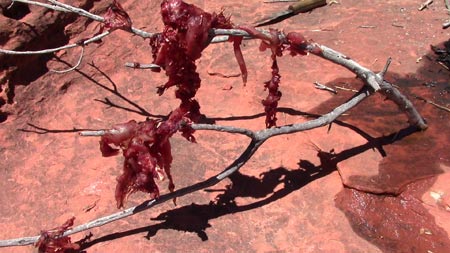
I put food so far down the list because you can go weeks, if not months, without food. That said, you are going to get hungry! The easiest things to eat are plants and insects since you don’t need tools to get them and they don’t always require cooking.
Insects should be cooked before you eat them to be on the safe side. That said, I have eaten thousands of insects raw and only gotten sick a few times.
Grasses are another easy and safe source of nourishment. Almost all grasses are edible raw. I usually chew the grass leaves to get all the juice out, then then spit out the fiber. It’s not much, but it really helps when you’re hungry.
Cattails are another great source of food because some part of the plant is edible any time of year. This is a really important plant to know and I have a great article on cat tails.
Learn about harvesting and preparing survival foods
Top of survival skills page
Signaling
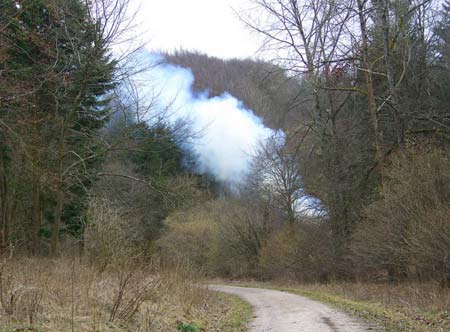
Knowing how to attract help is one of the most important survival skills if you want to go back to civilization. There are a few universal signals that you should know if you need help. And one really important signal you shouldn’t give if you do need help.
Waving both hands outstretched over your head as if to say “I’m right here! Here I am!” is a really bad idea. To would-be rescuers, you are waving them off and saying “I’m just fine.”
A large “X” in the sand or made with rocks tells aircraft operators that you can’t go any further and is seen as a distress signal. An “SOS” is also a good signal, but it takes more time and materials to make.
Top of survival skills page
Wilderness Navigation

Being able to find directions in different wilderness survival situations is important in some cases. Water usually flows south in the northern hemisphere. More moss generally grows on the north sides of trees. Different plant species can sometimes tell you if you are on the north or south side of a hill. Those indicators aren’t always accurate though.
The best way to find your way in the woods is knowing some basic constellations. Or, better yet, master the survival skills on this site so you don’t need to travel at all. You can just live comfortably until you are rescued or decide to walk out on your own.
Read my thoughts on wilderness navigation.
Top of survival skills page
Wilderness Survival Skills
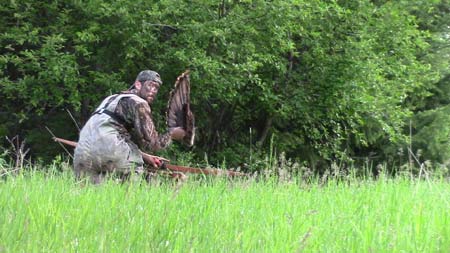
Knowing the core survival skills on this list will keep you alive. Mastering wilderness survival skills makes it easy to stay comfortable in the woods for as long as you want.
Learning wilderness survival skills is a fun and interesting way to spend time in nature. You can practice many of these survival techniques in your backyard or neighborhood park.
I like having the option to just “disappear” into the wilderness if I want to. I want you to have that option too. So, here are some of my articles on wilderness survival skills:
Wilderness survival skills main page
Crafts and fun stuff to do around the fire
How to make primitive baskets
How to make clay pots and containers
How to make string or cordage
Flint knapping
Making bone tools
Making stone tools
Cooking
How to track animals
How to tan an animal skin
Oil lamps and other lighting methods
Working with pine pitch
Top of survival skills page
Survival Kit
Having the right wilderness survival gear in your survival kit makes things a lot easier. At the least you need a knife and a way to make water safe to drink.
When I’m only going out for a week or so, I just take my wilderness survival knife and my LifeStraw.
When I go on hunting trips to film for the Outdoor Channel, I also take a little tin of survival gear with me.
And I have a long-term kit that I can use to make life really easy if I ever get to go in the woods for years again.
Wilderness Survival Kit:
My small survival kit
My long-term survival kit
Top of survival skills page
Contact John | Privacy | Terms and Conditions | Home
© 2021 John Yost. WorldWide Rights Reserved. Madison, Wisconsin
